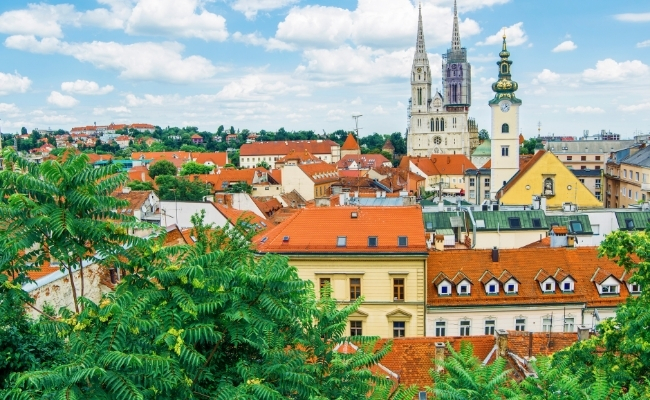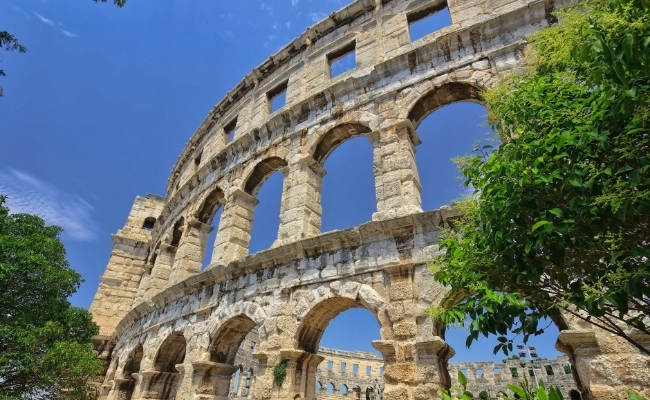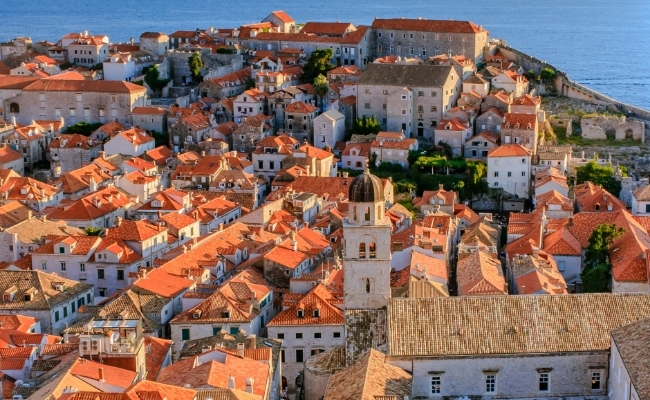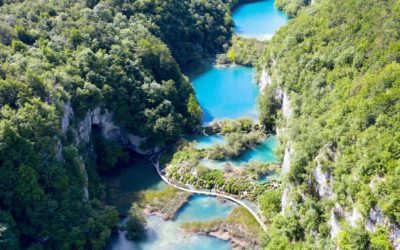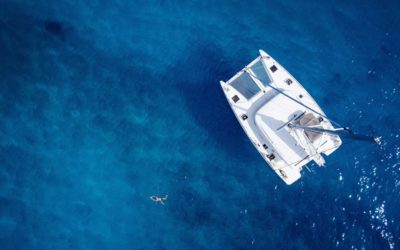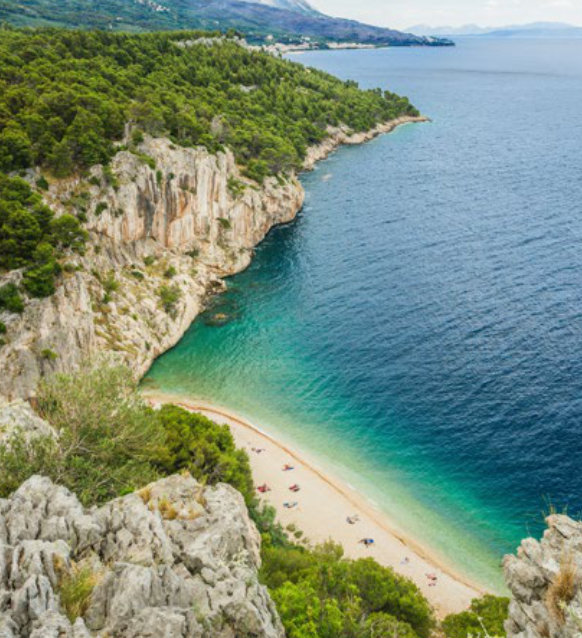Croatia Grand Tour: Land and Cruise
Croatia Tours (private journeys)
See the most of Croatia you can! 20 days from North to South, on land and by the sea!
Visiting: ZAGREB – PLITVICE LAKES NATIONAL PARK – SPLIT – OMIŠ – HVAR – STON – DUBROVNIK – BUDVA – KOTOR – DUBROVNIK – MLJET – KORCULA – HVAR – SPLIT – SIBENIK – KRKA – ZADAR – MALI LOSINJ – PULA – BRIJUNI – ROVINJ – POREC – POSTOJNA – LJUBLJANA – BLED LAKE – ZAGREB
Highlights
Itinerary
Day 1: ZAGREB
Unveil the secrets behind the old facades, discover the hidden courtyards and revive the stories from the past. We’ll give you a completely new perspective of Zagreb City. Walking tour of Zagreb starts with the main square Ban Jelačić, Cathedral, Tkalčićeva street, the Stone Gate, Upper Town, the historical center of the city, St. Mark’s Church with the famed multi-colored roof. Using funicular, close to the Lotrščak Tower, you can go down to the Lower town to see a part of the famous Ilica street, the Croatian National Theatre, University and more.
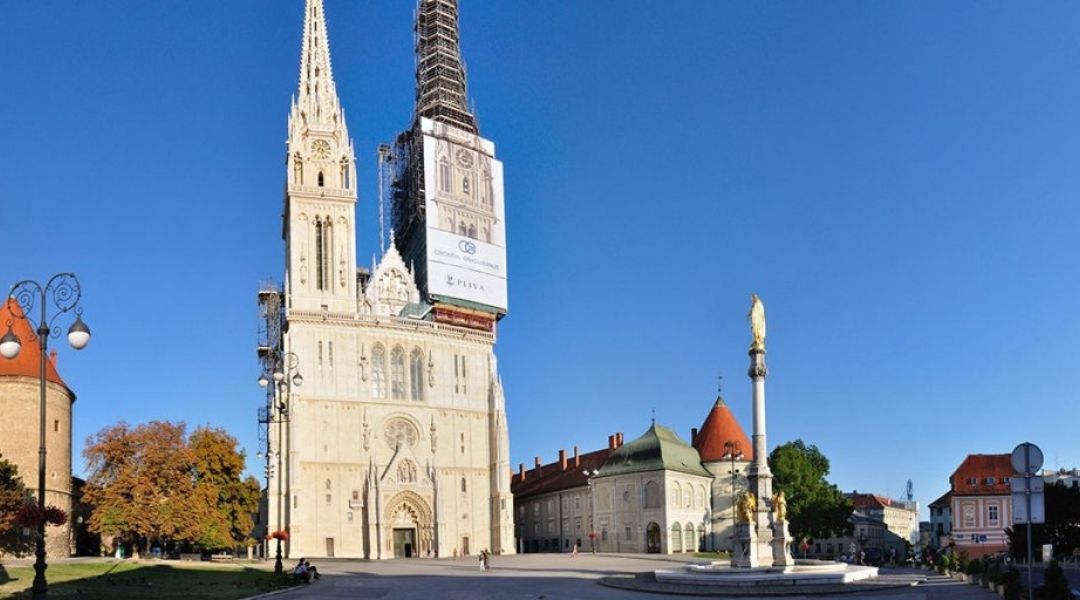
The Cathedral of the Assumption dominates Kaptol, its glowing towers you see off in the distance is the most immediately recognizable and commanding feature in town. It is an ornate and impressive wonder of neo-Gothic artistry. The cathedral was founded in 1093, heavily damaged in 1242 after various sieges by the Tartars, then again in 1625 after a wave of fires. But the bad luck goes on, in 1880 it was seriously damaged during an earthquake. In 1990 exterior renovations set in motion to battle against the wearing effects of time. Just up from the main square (Trg bana J. Jelacica) by the stairs, you will find the colorful Dolac market. To the back of the market square, there are the touristy stalls that sell souvenirs. But actually, the market itself is for the locals to buy fresh produce. Downstairs you will find the meat etc. sections.
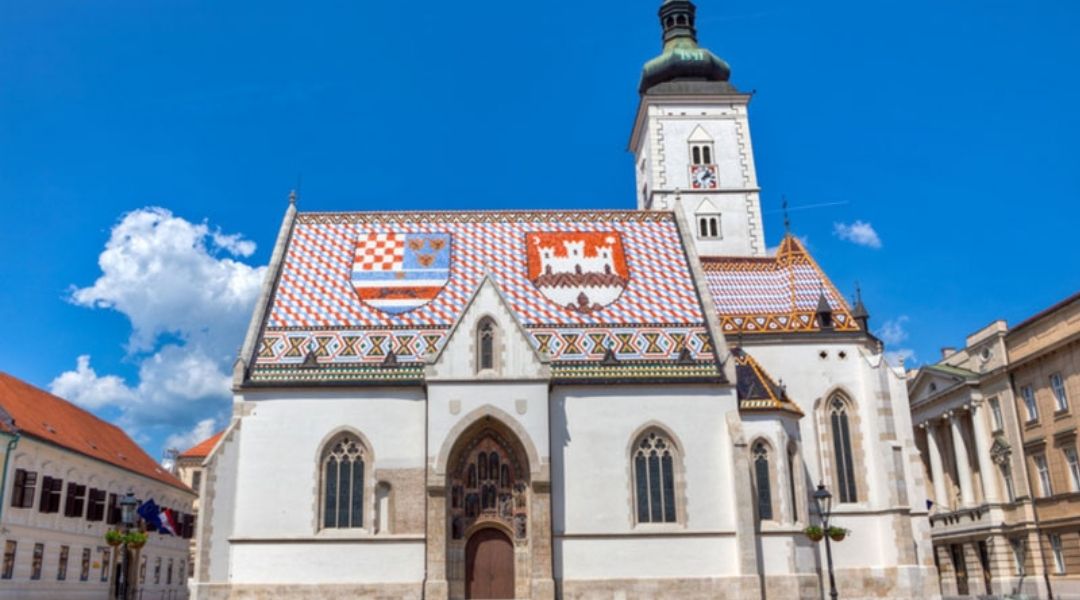
St. Mark’s Church – In the highest area of historic Zagreb this church is characterized by its roof with red, blue and white representing the coat of arms of Zagreb. The building was constructed by Venetian masters, even the baroque bell tower is an addition of the seventeenth century. Inside there are Gothic vaults and a choir designed by Ivan Mestrovic. The square where it is situated is a symbol of political life because here are the locations of the Sabor (Parliament), neoclassical building, and the Croatian government.
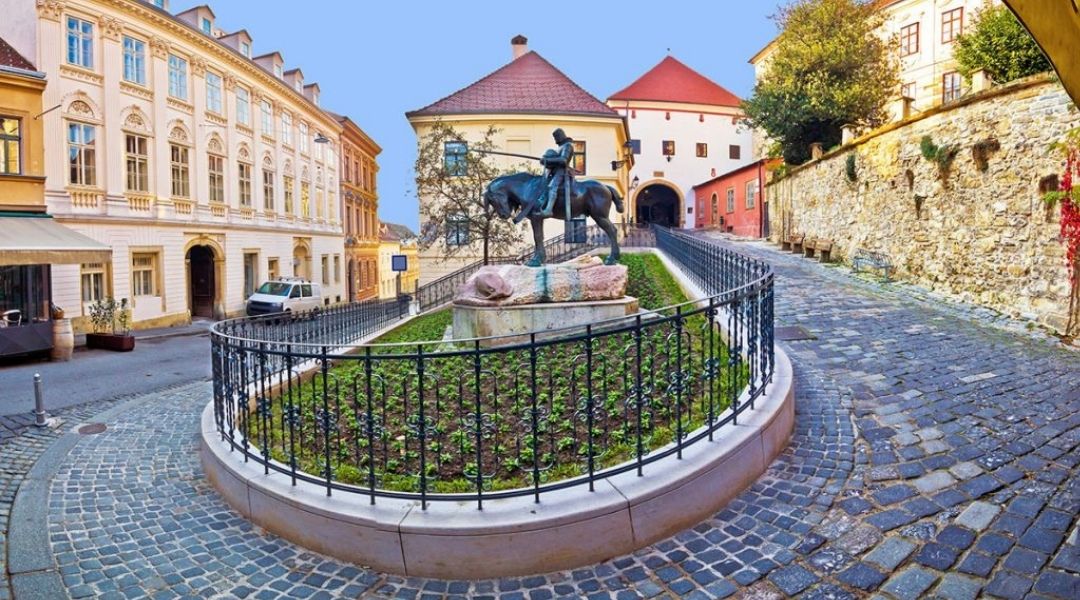
Stone Gate – Only one of the city’s four gates, the eastern one, has been preserved and this leads to the Gradec neighborhood. Apart from being practical, it’s also surrounded by a legend which is very important to Zagreb’s citizens who are very devout. According to this legend, the great fire of 1731 destroyed nearly all of the wooden doors except for a painting of the Virgin and Child by an unknown 17th-century artist. People thought that it was a magical or miraculous painting and since then, they have come to the site to pray and make offerings. On the inside of the doors on the wall, they have used the space as a chapel with benches for the people to pray before the image locked behind iron bars and surrounded by candles and flowers. Lower Town – Parks – Maksimir Park & Zagreb Zoo, (tram #7 if you are coming from the Central Bus Station or trams #11 and #12 from the main square or the #4 of your coming from the railway station). The biggest park in Zagreb. Great place to chill out, drink coffee, eat lunch (picnic or at the park’s restaurant) or take nice long walks through the forest or by the small lakes. Good for joggers, cyclists, also child and dog-friendly. Offers lake rowing. The 85-year old ZOO now also has red pandas and a variety of animals living in questionable conditions. Other city parks are connected in the “Lenuci Horseshoe”, an unfinished project of combining small green squares and parks at the core of the center of the town. Zrinjevac Park, (just south-east of the main square). the park of the Academy (connecting the Zrinjevac and Tomislav parks). King Tomislav square, (south of Zrinjevac, just outside the main Train Station). Botanical Gardens, (south of the K. Tomislav Square, near the Hotel Esplanade). Mažuranić square. Square of Maršal Tito, (the green square surrounding the National Theatre).
Itinerary
- Arrival to Zagreb and a private transfer to your centrally situated hotel
- Meeting with your guide for a private walking tour of Zagreb with a visit to the Museum of Broken Relationships
- Time at leisure to explore the city on your own, enjoy a drink or dinner in one of the many restaurants (on your own)
- Overnight in Zagreb
- Accommodation in a 4* hotel in Zagreb, double/twin room, BB basis
Day 2: ZAGREB – PLITVICE LAKES NATIONAL PARK
Rastoke – a watermill village situated where the blue-green water of river Slunjčica flows into the Korana river. Most of the houses were built at the end of the 19th and the beginning o¬f the 20th century. Because of its extraordinary natural beauties and historical tradition, in 1962 Rastoke village fell under the protection of the State Directorate for cultural and historical heritage. Many ancient civilizations, as well as contemporary urban environments, witness that the water has always attracted people to come to its banks and settle there. For thousands of years, the water of Korana and Slunjčica, and their flora and fauna fought the laws of nature, and as a result of this struggle in the limestone plateau, a remarkable canyon was carved in for us to take pleasure in.

Seeing this natural phenomenon, this “poured off” (“rastočen”) terrain, a place where the water of river Slunjčica pour off in several backwaters, leaving behind small elevations which then form watercourses and waterfalls, people built a village and named it RASTOKE. Here, they found everything they needed and stayed here, forever bound with nature. Rastoke is a village of ambiance value and authentic heritage when it comes to architecture, and according to some records, it was built in the 17th century, possibly even earlier. Most of the houses were built at the end of the 19th and the beginning of the 20th century. People have always lived in Rastoke. The grain from nearby villages was constantly being milled here, and since its location is by the main road – which connects the southern and northern part of Croatia – it became the intersection of various buyers, dealers and livestock traders. This rich village constantly suffered war damages and other social-caused troubles that destroyed it and set its development back to the beginning. Although people were forced to move away, nature always stayed and defied the odds with its distinctiveness. Because of its extraordinary natural beauties and historical tradition, in 1962 the Rastoke village fell under the protection of the State Directorate for cultural and historical heritage. During the Homeland War in the 1990s, the village was completely destroyed. It was renovated with the help of the Croatian Ministry of Development and Reconstruction. Today, there are about 30 households in Rastoke, and their wish is to renew the water mills and start running businesses.
Most of the households started renting out rooms for tourists.
Plitvice Lakes National Park is Croatia’s best known national park and the only one of eight that is listed on the UNESCO List of World Heritage sites. The main attractions of this park, are the 16 small lakes joined by waterfalls created by the sedimentation of travertine, a special type of limestone. This national park encompasses the source of the river Korana, located in the area surrounded by dense forests of beech, fir, and spruce. There are also several caves in the park, as well as springs and flowering meadows. The brown bear stands out as one of many protected animal species. The popularity of this park is also boosted by the special means of transport used to ferry visitors around: the panoramic electric trains and the noiseless electro-powered boats. By a network of paths, visitors can get around and access the numerous waterfalls and the rocky lake shores easily.
Itinerary
- Breakfast at the hotel and check out
- Private transfer from Zagreb to Plitvice Lakes National Park in a modern, air-conditioned van
- Entrance fees to NP Plitvice Lakes and a guided visit
- Terrain: Gravel & Steep
- Bring comfortable shoes and a jacket even in the summertime because the area is in the mountains and the climate is always fresh.
- In Plitvice guests will have to walk approximately 2000 meters over gravel and steep terrain, and take up to 300 steps.
- Note: This tour includes a significant amount of walking. Guests with walking difficulties are kindly requested to take this into consideration. Sun protection and comfortable shoes are suggested.
- Accommodation in a 4* hotel in Plitvice lakes area, double/twin room, BB basis
Day 3: PLITVICE LAKES NATIONAL PARK – SPLIT
Olives, indigenous aromatic plants, the brilliance of white stone against the verdant vegetation and the towering mountain massif of Biokovo whose spurs reach all the way to the sea – yes, this is indeed an exceptional part of the country, and its beauty is made all the more enchanting by numerous historic events and monuments. When, in the year 305, the Roman Emperor Diocletian, who ruled the entire world at that time, decided to build his leisure time abode – in which he intended to spend the rest of his life – he had no doubt as to exactly where build to it. In the very heart of Dalmatia, in the bay of Aspalathos (Split), well protected from the sea by the islands of the Split archipelago, and defended on its landward side by high mountains, Diocletian created a special point on the map of the Adriatic: the future city of Split.
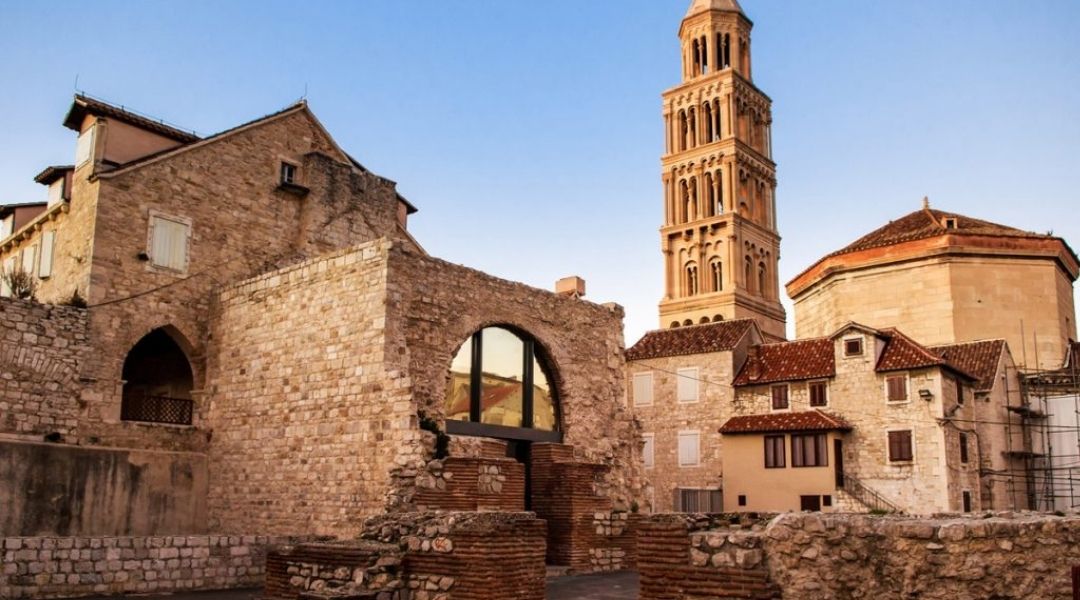
There’s no doubt Diocletian’s Palace is the top must-see attraction in Croatia’s second-biggest city –Split. This UNESCO protected World Heritage Site is actually the heart of the whole city – almost two thousand years old, the enormous palace exists today as a “living monument” – meaning it’s dotted with quaint shops, galleries, cafes, restaurants, and people actually live and work within its old walls. And that’s what makes it really special – it’s an ancient Roman palace absolutely integrated into the everyday life and doings of Split and its people.
The Riva, a marble-white and palm-lined connection of Split and the Adriatic is everyone’s favorite spot for socializing, coffee-drinking or just idle sitting on one of the comfy benches which face the sea. Riva is full of life throughout the day, especially during the summer, and you’ll always find people strolling along or sitting in one of the cafes. So, if you want to get a feeling of the local every day “buzz” be sure to grab your spot and you’ll soon experience firsthand how important and irresistible is the coffee culture in Croatia. Marjan hill, often referred to as the “green lungs of the city”, is a big forest park located close to the city center and fully equipped with walking, hiking and jogging trails. It’s a great choice for everyone who prefers less-crowded, wild beaches and thick pine tree shade. Moreover, if you’re looking for a picture-taking paradise, Marjan is your place! It offers stunning views of both Split and the surrounding islands. Marjan also hides some interesting historical sites such as old Jewish cemetery and 15th-century monasteries which are actually built into the hill. And finally, maybe not the most important but certainly the yummiest must-do activity of all – food! 😉 Split, especially its Old Town, is literally dotted with colorful food stalls, konoba (a type of traditional Dalmatian tavern) and quaint little restaurants. Don’t miss local delicacies, such as fish prepared na gradele and pašticada. Street food culture in Split is also pretty strong and you can never go hungry since there’s always some inviting bite-sized treat waiting for you around the corner.
Itinerary
- Breakfast at the hotel and check out
- Private transfer from Plitvice Lakes National Park to Split and accommodation in your hotel
- Meeting with your guide for an Exclusive Adventures Croatia private walking tour of Old Town Split.
- This tour will highlight the local customs and traditions related to food making.
- It will show you places of historical importance, take you to the places off the beaten path and give you the opportunity to taste local food.
- (approx 5 hours) Included: Walking tour Split, English speaking tour guide, insurance, pick up & drop off, meal in each food stop (1st stop – prosciutto & cheese and bread, 2nd stop – olive oil tasting, 3rd stop – a starter dish/salad, 4th stop – entrée dish, rakija tasting – 3 different rakija in 2 bars)
- Time at leisure and an overnight in Split
- Accommodation in a 4* hotel in Split, double/twin room, BB basis
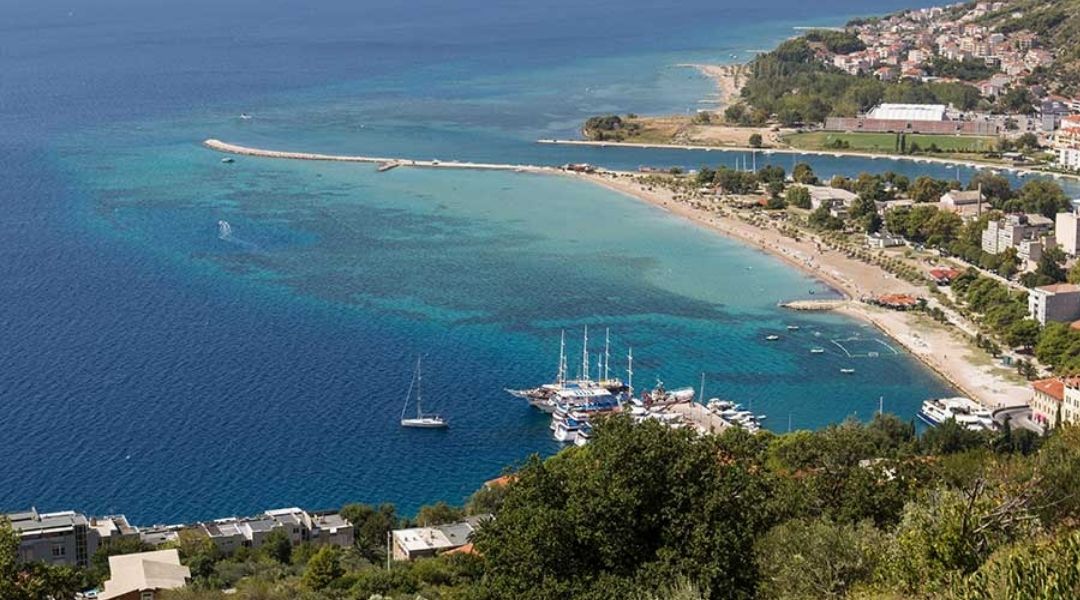
Day 4: SPLIT – OMIŠ – SPLIT
Omis is a small town and harbor in Central Dalmatian located between Split and Makarska, situated at the mouth of the Cetina river and surrounded with massive gorges. In the past, Omis was notorious because of the pirates of Omis whose ships were a centuries-long symbol of retaliation, courage, and strength. The evidence of a proud and turbulent Omis history can be found on every corner of the Omis Riviera. Omis churches and Omis fortresses are silent stone reminders of the power and the might of infamous Omis pirates. Today, Omis is one of the most beautiful places in Croatia’s Adriatic Coast. Thousands of years the Cetina River has been flowing persistently through the canyon, creating magical shapes in its bed. Crystal clear and pleasant for swimming, Cetina River today represents the genuine experience of the intact nature with its 180 meters high cliffs, wild rapids, basins, lakes, and subterranean tunnels. A full 3 hours of pure fun and a healthy dose of adrenalin to satisfy even the most demanding thrill junkies.
Zipline is an adrenaline activity where guests descend through the canyon down the steel rope, secured with a belt. The adventure also includes training and a short walk in nature. Zipline is located 3 km from Omiš, in the canyon of the Cetina River and consists of eight wires with a total length of 2100m. Depending on the size of the group you will experience an unforgettable three hours of fun and beautiful nature. Each group is followed by two guides.
Before the beginning, the group goes to the training ground and each guest receives equipment. There are two short cables, length 25m, where guides show you how to brake and act on the cable. Follows a short walk to the first cable, during which you can enjoy in almost untouched nature and a beautiful view of the canyon of the Cetina river. Before each cable, one of the guides attaches you and gives you instructions. On the other side, there is another guide who descended first and who will get you off the cable. In this way, you will pass all of the eight cables.
Rafting on the Cetina river is the most popular and most attended adventurous trip to Dalmatia. The three to four-hour-long rafting trip takes you down a 12-kilometer-long part of the Cetina course. Starting from the village of Penšići, the rafting route passes through an unforgettable scenery of impressive cliffs, playful waterfalls, and numerous rapids and ends at the excursion site of Radmanove Mlinice (the family Radman Mills), where you can take a rest and enjoy the amazing natural ambiance of fresh air and unique scenery, so different from the nearby Adriatic coast.
Itinerary
- Breakfast at the hotel
- Meeting with your driver for a private transfer to Omiš.
- OPTION A: Your instructors/guides will take you zipping your way across the magnificent Cetina River 150 meters above the canyon suspended by a wire! We have 8 wires running a total of 2100 meters. The highest one is 150 meters above the river canyon. The views from up here are incredible—a bird’s eye experience of some of the most magnificent nature in Croatia and the nearby seaside village of Omis is the perfect ending to an amazing day!
- OR, OPTION B: Meeting with your instructors in Omiš and a drive to the meeting point for a rafting adventure down a 12-kilometer-long part of the Cetina course
- The experience ends in Radman Mills restaurant where you will enjoy the traditional three-course lunch (drinks are not included)
- A return boat ride from the restaurant to Omiš
- Upon arrival to Omiš, explore the town briefly accompanied by an English-speaking guide
- Return drive to Split (meeting point TBC with the driver), time at leisure and an overnight in Split Private roundtrip transfers from Split to Omiš
- Accommodation in a 4* hotel in Split, double/twin room, BB basis
Day 5: SPLIT – HVAR
The lavender island that Conde Nast’s signature travel magazine called “one of the “best 10 islands in the world”. A vacation on the lavender island of Hvar means extraordinary experiences every day – from visiting an ancient olive grove and learning about what Homer called “liquid gold”, taking a ride to discover hidden inland Hvar to exploring a castle, visiting the oldest theatre in Europe or tasting spectacular wine and local delicacies at an award-winning vineyard.
Itinerary
- Breakfast at the hotel and check out
- Assistance with your luggage from the hotel in Split to Split Port
- Ferry tickets from Split to Hvar
- Private transfer from Stari Grad ferry port to your hotel
- The abandoned ethno – eco-village tour (Included: pick up, guide/driver, car transfer, dinner with wine in the abandoned village)
- OPTIONAL: boat taxi to Pakleni islands
- OPTIONAL: private walking tour of Hvar town
- Accommodation in a 4* hotel in Hvar, double room, BB basis
Day 6: HVAR
St. Stephen’s Square – The center of town is this rectangular square, which was formed by filling in an inlet that once stretched out from the bay. At 4500 sq. meters, it’s one of the largest old squares in Dalmatia. The town first developed in the 13th century to the north of the square and later spread south in the 15th century. Notice the well at the square’s northern end, which was built in 1520 and has a wrought-iron grill dating from 1780.
Cathedral of St Stephen – The cathedral forms a stunning backdrop to the square. The bell tower rises four levels, each more elaborate than the last. The cathedral was built in the 16th and 17th centuries at the height of the Dalmatian Renaissance on the site of a cathedral destroyed by the Turks. Parts of the older cathedral are visible in the nave and in the carved 15thcentury choir stalls. Renaissance Theater – Built in 1612, this theatre is reportedly the first theatre in Europe open to plebeians and aristocrats alike. It remained a regional cultural center throughout the centuries. Plays were still staged here right up until 2008. Although much of the theatre is still under renovation, you can wander around the atmospheric interior and take in the faded frescoes and baroque loggias. Franciscan Monastery & Museum – This 15th-century monastery overlooks a shady cove. The elegant bell tower was built in the 16th century by a well-known family of stonemasons from Korčula. The Renaissance cloister leads to a refectory containing lace, coins, nautical charts and valuable documents, such as an edition of Ptolemy’s Atlas, printed in 1524. Your eye will immediately be struck by The Last Supper, an 8m by 2.5m work by the Venetian Matteo Ingoli dating from the end of the 16th century. The cypress in the cloister garden is said to be more than 300 years old. The adjoining church, named Our Lady of Charity, contains more fine paintings such as the three polyptychs created by Francesco da Santacroce in 1583, which represent the summit of this painter’s work.
Fortica – Through the network of tiny streets northwest of St Stephen’s Square, climb up through a park to the citadel built on the site of a medieval castle to defend the town from the Turks. The Venetians strengthened it in 1557 and then the Austrians renovated it in the 19th century by adding barracks. Inside is a tiny collection of ancient amphorae recovered from the seabed. The view over the harbor is magnificent, and there’s a lovely cafe at the top. Arsenal – On the southern side of St Stephen’s Square, the Arsenal was built in 1611 to replace a building destroyed by the Ottomans. Mentioned in Venetian documents as ‘the most beautiful and the most useful building in the whole of Dalmatia’, the Arsenal once served as a repair and refitting station for war galleons.
Itinerary
- Breakfast at the hotel
- Meet your guide in the morning to depart on a special wine tasting tour of Hvar. Taste Croatia’s first and only wines that won the Paris World Wine Contest and the Decanter World Wine Awards in London! Our Taste of Hvar, the island of wine tour introduces you to two of Croatia’s most distinguished winemakers, including wine tastings.
- Return to Hvar town for time at leisure and a dinner on your own
- Accommodation in a 4* hotel in Hvar, double/twin room, BB basis
NOTE: Hvar wine tasting tour includes one of the above-mentioned wineries. You will have the opportunity to taste 4 – 5 different wines together with a specific wine guide, who will describe the individual wines and provide all information needed with islands finest local appetizers. Duration: 2-3 hours
Day 7: HVAR– STON – DUBROVNIK
The Walls of Ston are a series of defensive stone walls, originally more than 7 kilometers (4.3 mi) long, that surrounded and protected the city of Ston, in Dalmatia, part of the Republic of Ragusa, in what is now southern Croatia. The Walls of Ston were known as the “European wall of China”. Despite being well protected by massive city walls, the Republic of Ragusa used Pelješac to build another line of defense. At its narrowest point, just before it joins the mainland, a wall was built from Ston to Mali Ston. Throughout the era of the Republic, the walls were maintained and renovated once they meant to protect the precious salt pans that contributed to Dubrovnik’s wealth, which is still being worked today. Demolition work began on the walls following the fall of the Republic. Later the Austrian authorities took materials away from the wall to build schools and community buildings, and also for a triumphal arch on the occasion of the visit by the Austrian Emperor in 1884. The wall around Mali Ston was demolished with the excuse that it was damaging the health of the people. The demolition was halted after World War II.

The wall, today 5.5-kilometer-long wall links Ston to Mali Ston and is in the shape of an irregular pentangle. It was completed in the 15th century, along with its 40 towers (20 of which have survived) and 5 fortresses. Within, three streets were laid from north to south and three others from east to west. Thus, fifteen equal blocks were formed with 10 houses in each. Residential buildings around the edges. The Gothic Republic Chancellery and the Bishop’s Palace are outstanding among the public buildings. The main streets are 6 m wide (except the southern street which is 8 m wide) and the side streets are 2 m wide. The town was entered by two city gates: The Field Gate (Poljska vrata) has a Latin inscription and dates from 1506. The centers of the system are the fortress Veliki kaštio in Ston, Koruna in Mali Ston and the fortress on Podzvizd hill (224 m). Noted artists who work on the walls project are Michelozzo, Bernardino Gatti of Parma and Giorgio da Sebenico (Juraj Dalmatinac). The city plan of Dubrovnik was used as a model for Ston, but since Ston was built on prepared terrain, that model was more closely followed than Dubrovnik itself. In terms of infrastructure like water mains and sewers built in 1581, Ston was remarkably unique in Europe.
Itinerary
- Breakfast at the hotel and check out
- Meet your driver for a private transfer from Hvar to Dubrovnik via Pelješac peninsula with an en-route stop in Ston (a visit to Ston walls included)
- Stop in Mali Ston or Hodilje for oyster harvesting experience and a traditional lunch prepared with local mussels and shells
- Onward drive to Dubrovnik, accommodation in your hotel
- One-way transfer to Pile Gate meeting point
- Meeting with your guide for a private walking tour of the Old Town Dubrovnik (entrance fees not included)
- Evening on your own, (dinner suggestion)
- Return to the hotel on your own for an overnight
- Accommodation in a 4* hotel in Dubrovnik, double/twin room, BB basis
Day 8: DUBROVNIK
Dubrovnik is a medieval city on the Croatian side of the Adriatic coastline and treasure trove of cultural, historical monuments that were created throughout its thousand-year existence. In the past, it was a City-Republic, and alongside Venice one of the most famous cultural-economic centers on the Mediterranean. In more recent times, it has become the center of modern cultural and tourist events: a city of summer festivals – an international parade of top musical and theatrical achievements, a city of museums and galleries. These values have turned Dubrovnik into a place that offers a rich selection of various experiences and excitement, but also a complete holiday in a quiet and calming, mild Mediterranean ambiance and wonderful seaside landscapes.
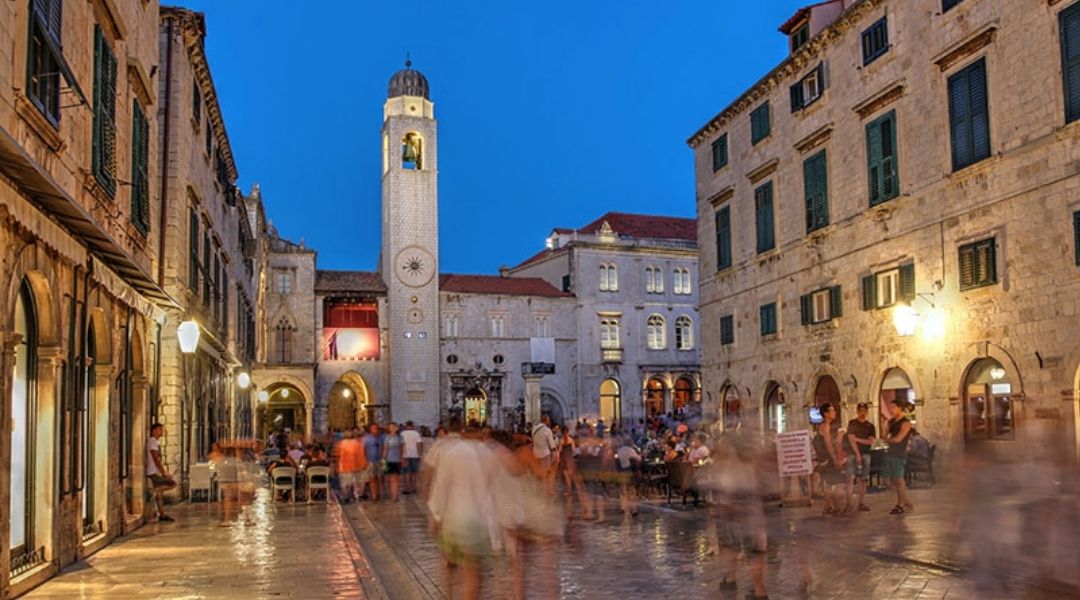
Stradun – the main street of Dubrovnik where everyone’s walked and also the busiest street where you stroll over marble tiles. Stradun is a great place for everyone where all the shopping can be done, cafes and restaurants are in the streets and many wonderful shops. Onofrio’s Fountain – this drinking fountain is located just at the beginning of Stradun, the main street of the old town. The structure was named after its builder, the Italian Onofrio de la Cava dates from 1440 and includes 16 sides. The concept is part of the water supply system of the city and brings water from the well in Rijeka Dubrovacka, at more than 20 km away, to the heart of the city. Before that this interest was, therefore, more than a masterpiece of architectural sophistication. Originally the fountain was decorated with a sculpture, which was destroyed in the earthquake of 1667, the Remaining 16 stone masks from which the water flows into a lake. The Clock Tower was built in the 15th Century right at the other end of the Placa (the main thoroughfare) and represented alongside nearby buildings a free city-state. The tower is approximately 31 meters in height and built by Grubacevic, Utisenovic and Radoncic, local masters. Following an earthquake, the structure of the Clock Tower lost its structure and leaned. In order for it not to fall the Clock Tower was rebuilt in 1929. Orlando’s column was Built in 1418, then it was the focal point of the city and Government ordinances and punishment carried out. A flag flies above the statue with the ‘Libertas’ motto. The medieval cult of Orlando (Roland) started here in the 12th century based on the epic poem ‘Song of Roland’
Itinerary
- Breakfast at the hotel and morning at leisure
- OPTIONAL: Meeting with your instructors at Pile Gate for a half-day group sea kayaking experience (starts beneath fort Lovrjenac in the small port called Pile). Explore caves and beauties of Lokrum island, where you will have a break for snorkeling and sandwiches. Upon return, discover why easy paddling in kayaks beneath the old city walls.
WEATHER PERMITTING- Includes: Kayaking & snorkeling gear, waterproof barrels for personal things, instructors/guides, sandwiches & water, insurance
What to bring a T-shirt, sun hat, waterproof shoes (not necessary), sunglasses, and sunscreen.
- Includes: Kayaking & snorkeling gear, waterproof barrels for personal things, instructors/guides, sandwiches & water, insurance
- Private transfer from your hotel to the lower station of Cable Car to Mt. Srđ
- Take the Dubrovnik Cable Car and reach a unique viewpoint above the city. (One-way tickets for Dubrovnik Cable Car included)
- Glide through the air on a scenic adventure. The Cable Car ride offers breathtaking views of the Old Town of Dubrovnik, stunning coastal sights, and magnificent sunsets. Once you reach the top, take your time and relax and enjoy the unique views of Dubrovnik and the Adriatic.
Also at the top, you will find the Homeland War Museum and take a short visit
- Glide through the air on a scenic adventure. The Cable Car ride offers breathtaking views of the Old Town of Dubrovnik, stunning coastal sights, and magnificent sunsets. Once you reach the top, take your time and relax and enjoy the unique views of Dubrovnik and the Adriatic.
- Walk down the hill to local konoba for a farewell dinner (Three-course dinner, drinks not included)
- English speaking guide for the private walking tour of Old Town Dubrovnik (entrance fees not included)
- Private transfer back to your hotel, time at leisure and an overnight in Dubrovnik
- Private round-trip transfer from the hotel to Old Town Dubrovnik and from Konoba Dubrava back to your hotel in a modern, air-conditioned van
- Accommodation in a 4* hotel in Dubrovnik, double room, BB basis
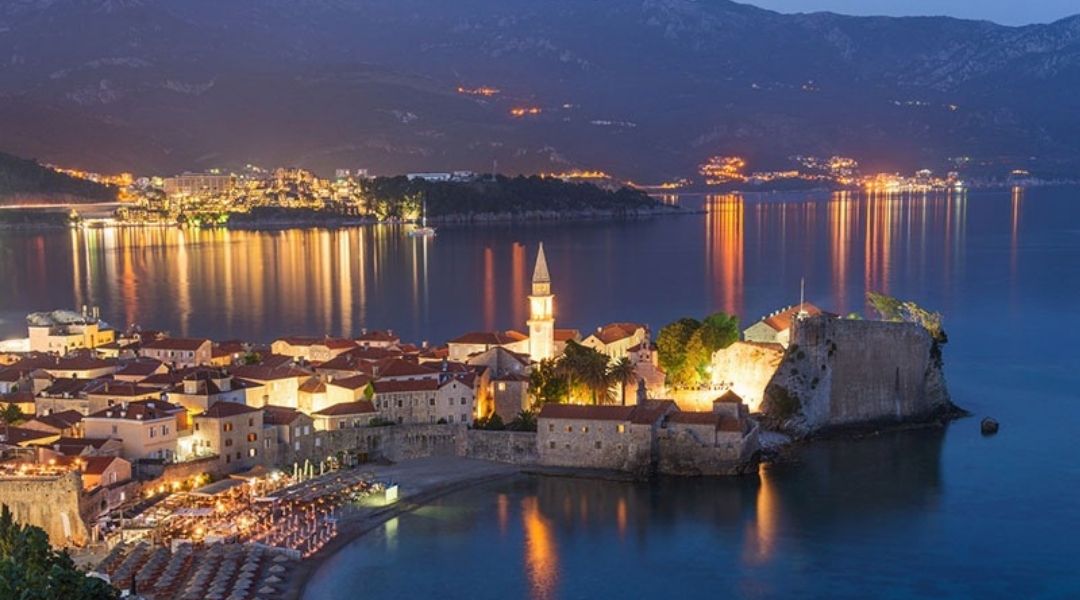
Day 9: DUBROVNIK – MONTENEGRO
Visit Montenegro on a day trip from Dubrovnik, and discover the delights of the tiny country that’s said to be one of Europe’s best-kept secrets. With a population of a bigger European city suburb (650.000), Montenegro is an enchanting little country full of extreme geographical diversities. Great mountains with snow peaks, steep fiord-like hills almost vertically diving into the Adriatic Sea, mountain lakes full of fish, mystical monasteries carved in the solid rock, sandy and sunny beaches that go on for miles alongside the coast…. that is all Montenegro. The Montenegrin Adriatic coast is 295 km long, with 72 km of beaches, and with many well-preserved ancient old towns. The main attractions along the north coast are: The Old Town of Herceg Novi, the old town of Kotor – listed with UNESCO world heritage sites, Boka Kotorska (Bay of Kotor), with the ancient small town of Perast, the old town of Budva – a well preserved old town, Sveti Stefan – a small island hamlet turned into a luxury hotel, etc.
Itinerary
- Breakfast at the hotel
- We start our tour from Dubrovnik driving south alongside Adriatic coast passing cities of Cavtat and Konavle region and soon cross the border to Montenegro (do not forget your passports). We are driving alongside the Kotor bay (Europe’s most southern fiord) passing the cities Igalo, Herceg Novi (two great Turkish, later Venetian fortresses), and finally reach the city of Kotor, nestled in the very bottom of Kotor bay surrounded by formidable verticals of neighboring mountains.
- Hotel pick-up
- Drive to Budva with a panoramic stop and ferry ride
- Free time in Budva
- Drive to Kotor
- City tour and free time in Kotor
- Drive from Kotor to Dubrovnik with a panoramic stop Group full-day excursion to Montenegro (Included: hotel pick up/drop off, transportation, transportation fees, guide, local guide in Kotor, City tour of Kotor.)
- Duration: full day/ up to 12 hrs
- What to wear: casual wear
- What to bring: camera, passport
- Local currency: Euro, €, code: EUR
- Not included: Entrance tickets to museum (optional), lunch
- Accommodation in a 4* hotel in Dubrovnik, double/twin room, BB basis
Day 10: DUBROVNIK - Embark Deluxe Cruise
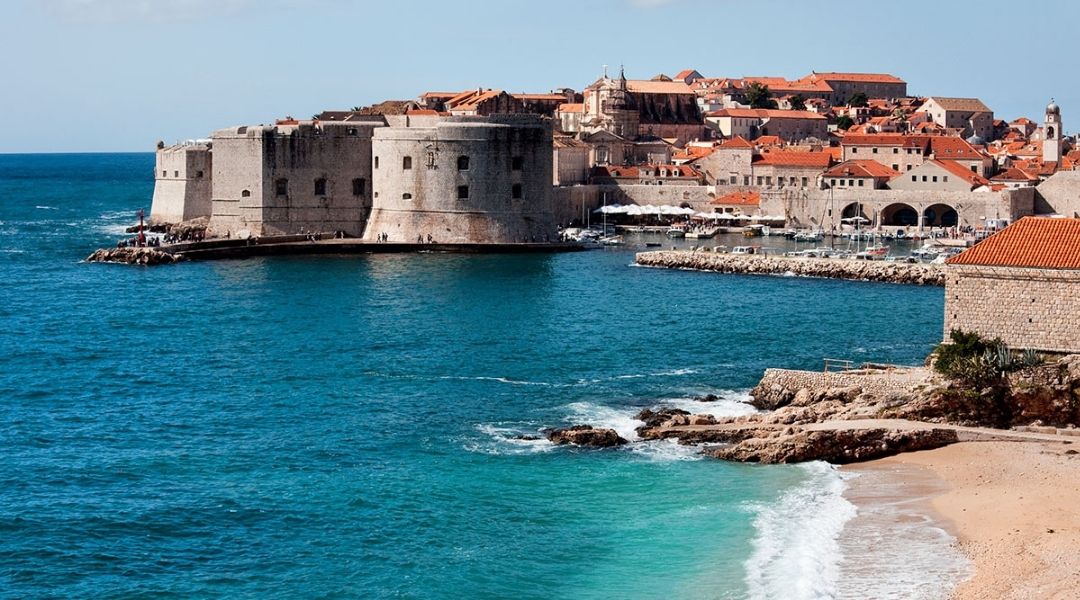
Itinerary
- Breakfast at the hotel and check out
- Meeting with your driver for a private transfer to Dubrovnik Port and embark on a Deluxe Cruise (Double Cabin)
- Settle in your cabin, before attending a Welcome reception followed by dinner this evening. (WD)
Day 11: DUBROVNIK – MLJET – KORCULA
After breakfast, morning walking tour of Dubrovnik, the “Pearl of Adriatic” and a UNESCO World Heritage site. You’ll visit the Rector’s Palace and Franciscan Monastery’s Pharmacy.
Return for lunch on board and set sail towards the beautiful Mljet Island. Visit Mljet National Park, featuring five types of forest, many species of birds, and two deep lakes, Big and Small Lake. Continue the cruise to the magical island of Korcula and its fairy-tale like walled town bearing the same name, believed to be the birthplace of the explorer Marco Polo. The walking tour takes you through its narrow, cobbled streets and includes a visit to the majestic Gothic-Baroque Cathedral of St. Mark. Tonight, enjoy dinner on board. (B, L, D)
Day 12: HVAR – SPLIT
Welcome to Hvar, Croatia’s sunniest island. Hvar is a favorite holiday destination for international celebrities and yachters; thus, beyond all the glitz and glamour, Hvar town is a charming seaside resort with 8 centuries of architecture waiting to be explored. On a walking tour, breathe in the pine-scented breeze, as you absorb vistas of the old town with the picturesque little streets and the first public theatre in Europe. Enjoy some free time to pop into craft shops or cafes, tucked into old Venetian palaces. Board back your ship in time for lunch, and cruise to Split.
Afternoon walking tour, featuring the historic inner city, built around the Roman Emperor Diocletian’s Palace, a UNESCO World Cultural Heritage site. See the remnants of Split’s Roman heritage, its Renaissance and Gothic structures, Jupiter’s Temple and the Cathedral. The evening is free, to stroll along Riva, try local cuisine and enjoy local vistas. (B, L)
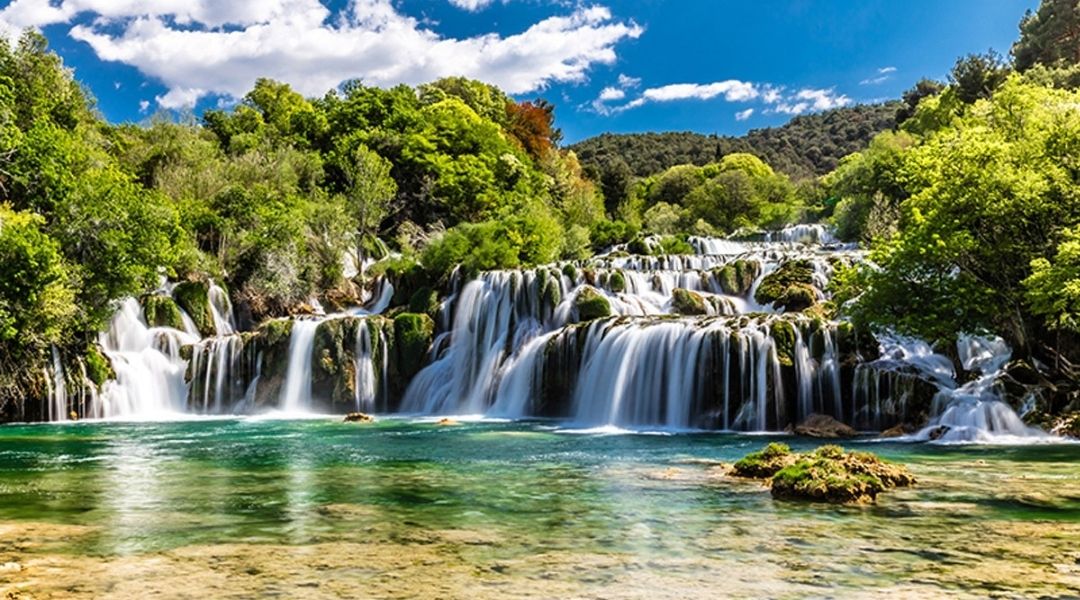
Day 13: SIBENIK – KRKA NATIONAL PARK – VODICE – ZADAR
Morning visit to Krka National Park, with its magnificent waterfalls.

Afterward, coach to Vodice, return to the ship and enjoy lunch, while sailing to Zadar, a city of exceptional history and rich cultural heritage.
In the late afternoon, set out on a walking tour of Zadar historical center and admire the old walls built in 16th century by Venetians as a defense from Turks. Also see the 16th century Port Gate where the Venetian lion still guards the entrance, the Square of the Five Wells, Church of St. Donat, the Roman Forum and the largest cathedral in Dalmatia, St. Anastasia. Your evening is at leisure in town. (B, L)

Day 14: ZADAR – MALI LOSINJ
Today, we set our compass north, with a morning stop for swimming in one of the small islands. Lunch aboard, while continuing our journey towards Mali Losinj, located on the island with the same name. Thanks to its mild climate, pinewoods, and air, the island of Mali Losinj is an ideal place to recreate your body and spirit. Captain’s dinner with live entertainment aboard our ship tonight. (B, L, D)
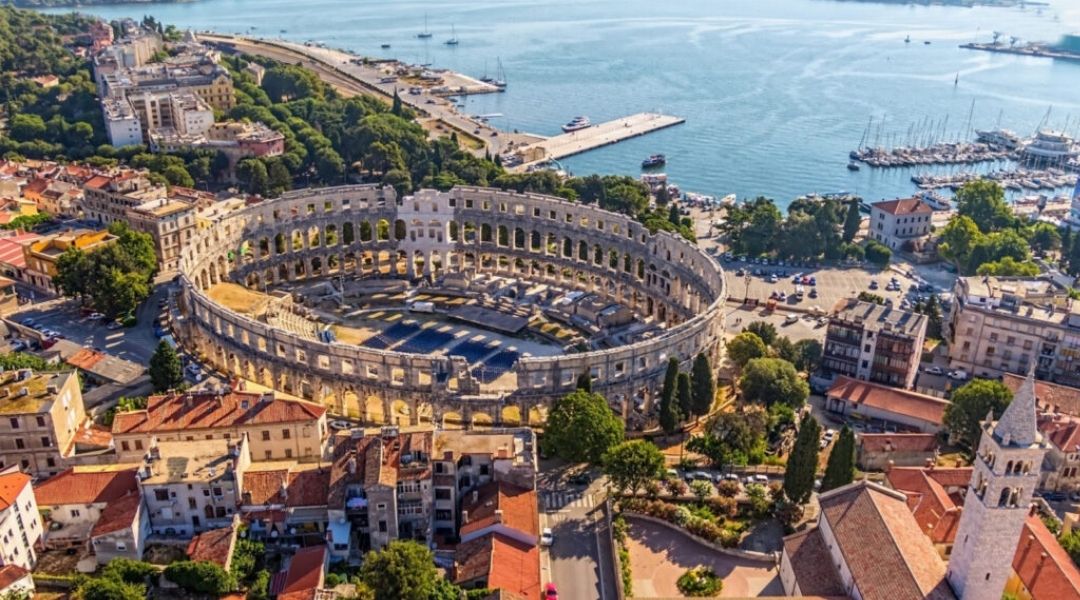
Day 15: MALI LOSINJ – PULA
Morning sailing with lunch aboard. In the afternoon, visit Pula, arguably one of the most beautiful of Istrian cities. Your guide will share some exciting stories of antiquity, as you walk the footsteps of the ancients and visit the Amphitheatre. The rest of the day at leisure to discover this Roman town on own. (B, L)
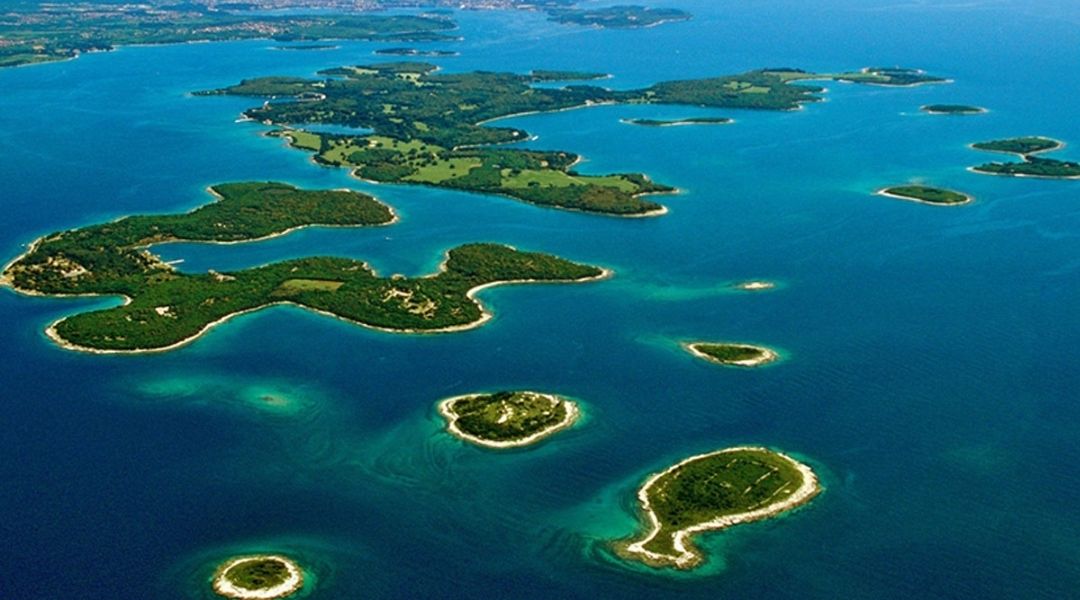
Day 16: PULA – NATIONAL PARK BRIJUNI – ROVINJ – POREC
Continue sailing to the Brijuni National Park, once the personal State Summer Residence of President Marshal Josip Broz Tito. Arriving at the island, a part of heaven discloses in front of your eyes in the unique harmony of flora, fauna, and heritage. Following the visit, lunch aboard, before we reach a romantic town of Rovinj. Feel its past times as you walk around the Old Town’s cobbled narrow streets, winding at the foot of the Church of St. Euphemia, the favorite gathering place of artists from around the world. Conclude your lovely cruise in Porec and say farewell to your new friends at dinner in the local restaurant. Return to your cabin for the last night on board. (B, L, D)

Day 17: POREČ – POSTOJNA – LJUBLJANA
After breakfast, it’s time to disembark. End Cruise.

Postojna Cave is a network of 20 kilometers of passages, galleries, and chambers into which experienced guides have accompanied more than 35 million visitors in the last 188 years. It is the largest cave in the “classic karst” and the most visited show cave in Europe. In 1872 railway lines were laid in the cave; electricity arrived in 1884. Today you begin your visit aboard the cave train; the electric lighting allows you to admire the size and splendor of the underground world, where the geological past is recorded in a unique manner. Visitors to the cave are dazzled by a wealth of speleothems: calcite formations, stalactites, and stalagmites abounding in a variety of shapes, colors, and ages. The constant temperature in the caves ranges from 8 to 10° C A trip to the Postojna Cave can be an all-day adventure, brimming with surprising discoveries. Decide which of the numerous adventures inside the Postojna Cave and the surrounding area you would like to take part in. Postojna Cave is the best-known cave in the world. It is also the greatest tourist attraction in Slovenia and one of the world’s largest karst monuments. For 140 years, the Postojna Cave, as the only cave in the world, offers a unique and adventurous ride with a special train, which will take you into the cave, under spectacular underground arches, which are embellished with chandelier look-alike stalactites, through a beautiful subterranean world full of playful limestone sculptures. In 1819 Archduke Ferdinand I visited the cave and became the first official visitor. This gave rise to tourism in Postojna and this date is considered the official start of modern cave tourism although signatures dated from the 13th century can be found in the cave.
Itinerary
- Breakfast on board, disembarkation by 9 am
- Meeting with your driver for a private excursion to Postojna and a visit to Postojna Cave and Predjama Castle
- Onward drive to Ljubljana, time at leisure and overnight at your hotel
- Private excursion from Porec to Postojna in a modern, air-conditioned car accompanied by an English speaking driver
- Entrance fees to Postojna Cave and Predjama Castle (visit on your own in organized groups)
- Accommodation in Hotel 4* in Ljubljana, double room – single use, BB basis
Day 18: LJUBLJANA
Ljubljana Castle lies atop Castle Hill and is a well-known landmark here. This monument has served as military housing as well as the royal residence over the past centuries. The Dragon Bridge truly symbolizes the history, beauty and architectural style of Ljubljana and adds glamor to its skyline. This is, in fact, the first bridge in the entire world to have been constructed using reinforced concrete. You can identify St. Nicholas Cathedral by its twin towers and green colored dome. Built in the year 1707, the church is dedicated to the popular saint of boatmen and fishermen of this region.
To truly enjoy Ljubljana sights and get a feel of the city, you can visit the city market. Its picturesque setting near baroque and cathedrals make it a nice place to visit. You can buy all kinds of fresh fruits and vegetables, spices, herbs, local arts, and crafts and Slovenian delicacies like horse pate, Karst prosciutto, oils, cheeses, ‘potica’ cake and more in this area.
The Town’s main square was destroyed by an earthquake in the 15th century and was later remodeled in true Baroque style. The square is home to the Souvan House, City Art Museum, Town Hall and the ancient Lichtenberg house. Preseren Square has a statue of France Preseren, Slovenia’s most famous poet overshadowed by the poetic muse. In a corner of the square, his lover gazes across at him. Preseren Square is surrounded by beautiful buildings such as the salmon pink Franciscan Church, which is lovely and peaceful inside. This church dates from the seventeenth century. There is also the oldest department store in Ljubljana- a beautiful art nouveau building with a statue of the god Mercury on its roof and a lovely ornate staircase inside. The central element in touristy Ljubljana is this triple bridge. The central part is the original bridge, built in 1842 and designed by an Italian architect. In 1929, Joze Plecnik, trying to eliminate congestion in traffic, planned, and built, ending in 1932, two side narrow bridges for pedestrians. Leaving Preseren Trg and crossing the Triple Bridge you will enter Ljubljana’s Old Town and Mestni Trg.
The Robba Fountain is located at the center of mestni Trg just by the Town Hall and is one of Ljubljana’s best examples of Baroque monumental architecture. the fountain is also known as The Fountain of Three Carniolan Rivers. It was built between 1743 and 1751 by the sculptor and architect Francesco Robba (1698-1757) who spent most of his life in Ljubljana and is contributed greatly to Ljubljana’s present-day architecture along with Jaze Plecnik. The Fountain has sculptures depicting three river gods which represent three Carniolan rivers – the Sava, the Ljubljanica and the Krka.
Itinerary
- Breakfast at the hotel
- Meeting with your guide for a private walking tour of Ljubljana with a visit to Ljubljana Castle and a cable car ride (entrance fees to be paid on spot)
- Time at leisure to explore the city on your own, do some shopping or enjoy watching people passing by in one of the many cafes lined next to the river Ljubljanica
- OPTIONAL: Dinner at a traditional, local restaurant Sokol
- Time at leisure and overnight in Ljubljana
- Accommodation in Best Western Premier Hotel Slon 4* in Ljubljana, double room, BB basis
Day 19: LJUBLJANA – BLED LAKE – ZAGREB
Bled, the town that exists for thousand years, sheltered by picturesque mountains, with an Alpine lake and the only Slovenian island that reigns in the middle. Lake Bled is truly the jewel of Slovenia with its legendary island in the middle of the lake, castle and hot springs. Its beneficial climate has attracted numerous cosmopolitan visitors for centuries. The most renowned symbol of the island is the Church of the Assumption which demands a climb up the 99 stone-step staircase. As far as the wishing bell is concerned. Don’t just watch it. Ring it. Climb up to Bled Castle and enjoy the finest view of the lake with its island. Demonstration of printing on a reconstructed Gutenberg’s printing machine and prints of certificates is available. The Bled Castle offers the finest view of the Bled island, the town of Bled and of the wider countryside of the Gorenjska region. Experience the picturesque architecture of the castle and the museum collection, representing the historical development of Bled, its culture, and its population. Get familiar with the traditional manual technological procedures of printing in the castle printing shop, order a small bottle of wine and seal it with sealing wax in the castle cellar, and get acquainted with artistic ironworks at the castle forge. Recover your strength in the castle restaurant and then visit the multi-vision.
Itinerary
- Breakfast at the hotel and check out
- Meeting with your driver and a guide for a private transfer to Bled. Upon arrival, you will take a walking tour of Bled town with a visit to Bled Castle, pletna boat ride and a visit to the Church of the Assumption of Mary that you reach after 99 steps. The wishing bell is another attraction because when you ring the bell, make a wish and it will be granted. (English guide and entrance fees included)
- In the afternoon your onward drive to Zagreb will follow and accommodation in the capital city of Croatia
- Meeting with your guide for a private walking tour of Zagreb (English guide and entrance fees included)
- Time at leisure and overnight in Zagreb
- Accommodation in Hotel 4* in Zagreb, single room, BB basis
Day 20: ZAGREB
Itinerary
- Breakfast at the hotel and check out
- Private transfer from your hotel to Zagreb Airport
- Private transfer from Zagreb to Zagreb Airport in a modern, air-conditioned car

This package includes:
- Private transfer from Zagreb Airport to your centrally situated hotel in a modern, air-conditioned car
- Private walking tour of Zagreb with a visit to Museum of Broken Relationships (entrance fee included)
- 1 night in a 4* hotel in Zagreb, double/twin room, BB basis
- English speaking tour leader throughout with covered expenses
- Private transfer from Zagreb to Plitvice Lakes National Park in a modern, air-conditioned van
- Entrance fees to Plitvice Lakes National Park and a guided visit
- 1 night in a 4* hotel in Plitvice Lakes area, double/twin room, BB basis
- Private transfer from Plitvice Lakes National Park to Split hotel in a modern, air-conditioned van
- Exclusive Adventures Croatia Taste of Split – long tour (approx 5 hours) Included: Walking tour Split, English speaking tour guide, insurance, pick up, drop off, a meal in each food stop (1st stop – prosciutto; cheese and bread, 2nd stop – olive oil tasting, 3rd stop – a starter dish/salad, 4th stop – entrée dish, rakija tasting – 3 different rakija in 2 bars)
- 2 nights in a 4* hotel in Split, double/twin room, BB basis
- Private round trip transfers from Split to Omiš in a modern, air-conditioned van
- OPTION A IN OMIŠ: Zipline adventure in the outback of Omiš area (transfers, Insurance, instructors included)
- OPTION B IN OMIŠ: Rafting on the Cetina river (Included: Transfer from Omiš to Peršići meeting point, Professional licensed instructor, Rafting equipment, Safety gear, Insurance, with final transfer back)
- Three-course lunch in a traditional restaurant Radman Mills where the morning experiences finish (drinks not included)
- A boat ride from Radman Mills restaurant to Omiš city center and a walking tour of Omiš
- Assistance with your luggage from the hotel in Split to Split Port
- Ferry tickets from Split to Hvar
- Private transfer from Stari Grad ferry port to your hotel
- The abandoned ethno – eco village of Malo Grablje tour (Included: pick up, guide/driver, car transfer, dinner with wine in the abandoned village of Malo Grablje)
- 2 nights in a 4* hotel in Hvar, double room, BB basis
- Hvar wine tasting – Included: pick up, guide/driver, car transfer, wine tasting.
- Private transfer from Hvar to Dubrovnik via Pelješac peninsula with en-route stop in Ston (Ston Walls tickets included) in a modern, air-conditioned van
- Stop in Mali Ston or Hodilje for oyster harvesting experience and a traditional lunch prepared with local mussels and shells
- One-way transfer to Pile Gate meeting point
- English speaking guide for the private walking tour of Old Town Dubrovnik (entrance fees not included)
- 3 nights in a 4* hotel in Dubrovnik, double/twin room, BB basis
- Private round trip transfer from the hotel to Old Town Dubrovnik and from Konoba Dubrava back to your hotel in a modern, air-conditioned van
- English speaking guide for the private walking tour of Old Town Dubrovnik (entrance fees not included)
- One-way tickets for Dubrovnik Cable Car
- Three-course dinner in Konoba Dubrava (drinks not included)
- Group full-day excursion to Montenegro (Included: hotel pick up/drop off, transportation, transportation fees, guide, local guide in Kotor, City tour of Kotor.)
- Private transfer from Dubrovnik Hotel to Dubrovnik Port in a modern, air-conditioned car
- 7 Nights in A/C cabin with en-suite bathroom
- Welcome Dinner (D)
- 10 Breakfasts, 6 Lunches (B, L)
- 2 Restaurant Dinners (D)
- 1 Captain’s Dinner with live entertainment including wine, beer, and soft drinks (D)
- Bottled water, tea, and coffee
- Cruise Director
- Free Wi-Fi (restrictions may apply)
- Service charges & port taxes
- Headsets for sightseeing tours
- Porterage
- Private transfer from Porec to Postojna, to Ljubljana in a modern, air-conditioned car accompanied by an English speaking driver
- Entrance fees to Postojna Cave and Predjama Castle (visit on your own in organized groups)
- 2 nights in Hotel 4* in Ljubljana, double room, BB basis
- English speaking guide for a private walking tour of Ljubljana (entrance fees not included)
- Private transfers from Ljubljana to Bled followed by a final drive to Zagreb in a modern, air-conditioned car
- Private half-day excursion to Bled (English guide and entrance fees included)
Entrance fees included, while on Cruise:
- Brijuni – National Park
- Pula – Amphitheatre Arena
- Olib – Assumption of Mary Church
- Zadar – Cathedral of St Anastasia
- Krka Waterfalls – National Park
- Split – Diocletian Palace
- Korčula – Cathedral of St Mark
- Mljet – National Park
- Dubrovnik – Rector’s Palace, Franciscan Monastery Pharmacy
Sightseeing, while on Cruise:
- Rovinj
- Brijuni NP
- Pula
- Mali Lošinj
- Susak
- Olib
- Zadar
- Krka NP
- Šibenik
- Split
- Hvar
- Korčula
- Mljet
- Dubrovnik

The program does not include:
- Meals and drinks not mentioned above
- Airfare
- Travel Insurance
- Additional excursions and/or services not mentioned in the program
- Personal expenses (internet, telephone, mini bar etc.)
- Tips and porterage services
Dates and Pricing
PRICES FROM
$8,700
per person, based on Cruise dates and availability
TRAVEL BETWEEN
May – October
Double Occupancy Cabins
